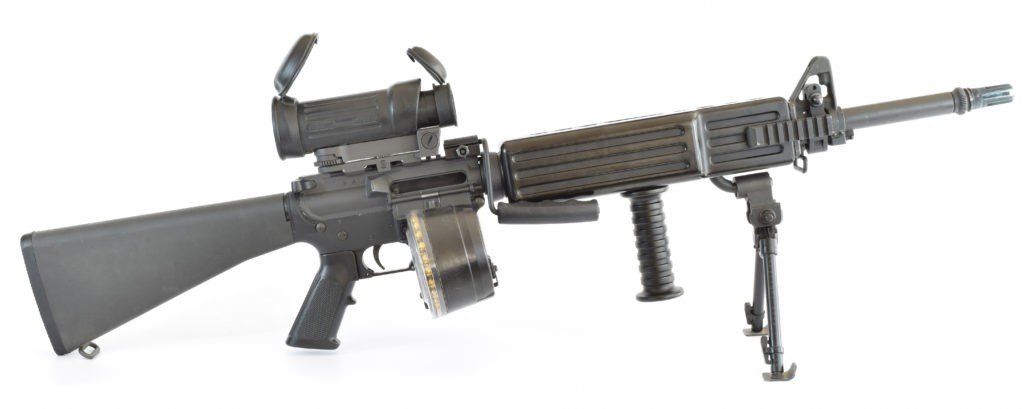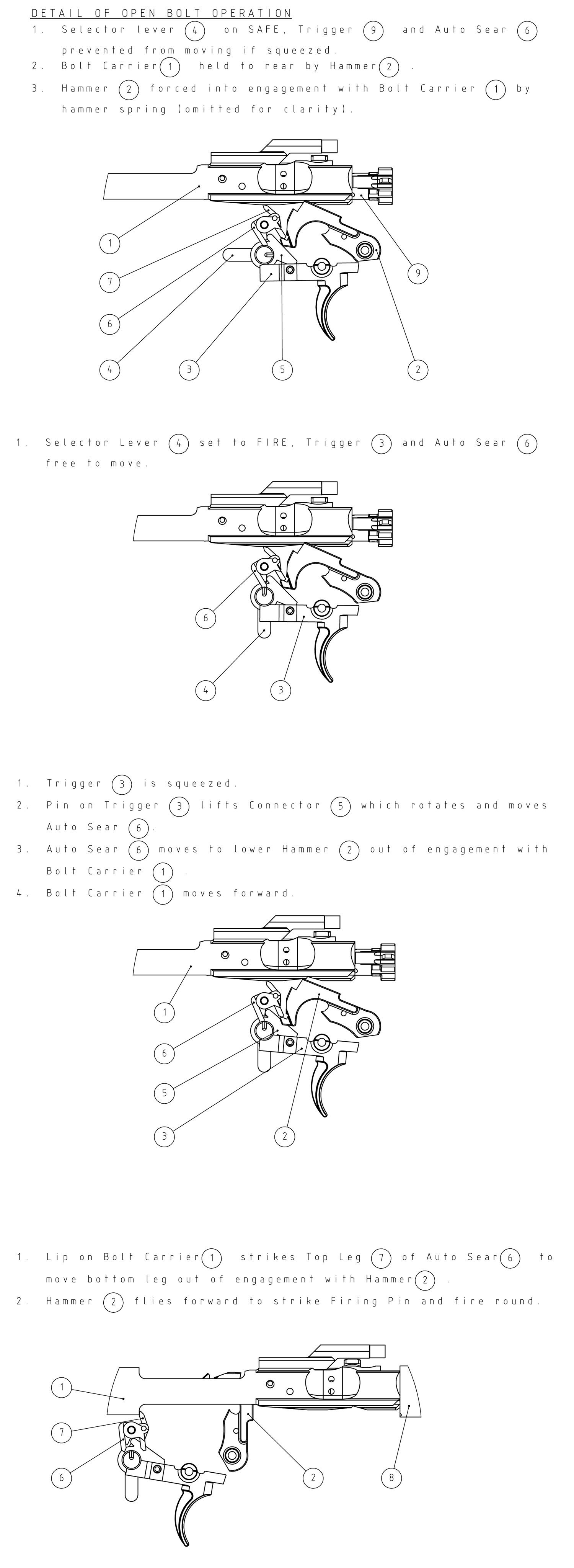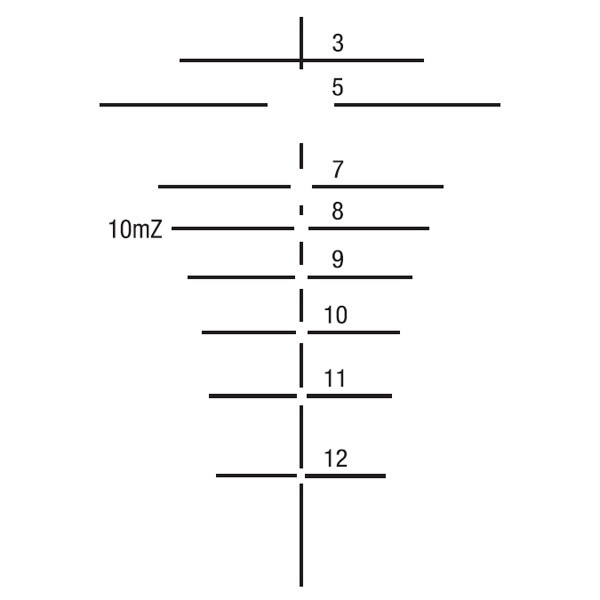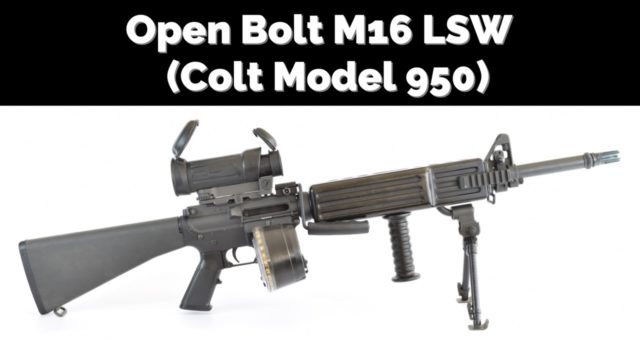History
Ever since Colt acquired Eugene Stoner’s design for the M16 from Armalite, they have been trying to use it in designs to fit various roles required by the military. Colt in the past has made several heavy barrel M16s to serve the Squad Automatic Weapon (SAW) role. The initial designs were nothing more than their standard closed bolt M16 with a heavier barrel, bipod, and fore grip. The problem when using a closed bolt weapon, without a quick change barrel (QCB), in a sustained fire role is the possibility of cook off. Cook off occurs when the barrel of the weapon has become so hot the cartridge will ignite from the barrel heat alone. This can cause the gun to fire without manipulation of the trigger even when the weapon is on Safe. Typically, firearm designers utilize an action that fires from an open bolt to solve the issue. Open bolt operation does not feed the cartridge into the chamber until the trigger is pulled. Cook off is mitigated since the cartridge cannot absorb the chamber heat. The open bolt also allows air to circulate through the barrel bore while the weapon is not being fired thus cooling the barrel further.

Colt sought to create a SAW design utilizing as much of the existing M16 parts family as possible while firing from an open bolt. Colt’s engineer, Henry Tatro, designed a trigger group that allows the M16 to fire from an open bolt without any modifications to the receiver. US Patent No. 4,433,610 was granted in 1984 for his design. The LMG open bolt trigger group should not be confused with the open bolt firing mechanism Colt uses in the M231 Port Firing Weapon.
Diemaco, who produces M16s for Canada, incorporated the open bolt trigger group in their LMG design. The design became the open bolt M16 LMG (Colt Model 750). Modernization of the Model 750 to a flat top upper receiver, addition of a bayonet lug, 1913 rails on either side of the front sight block, and relocation of the bipod to a spigot mounted off the barrel resulted in the Colt Model 950. Colt markets it as the Light Support Weapon (LSW) and/or Automatic Rifle. The Model 950 was submitted to the US Marines for trials in 2001 but was not adopted for use. The Danish military have adopted the LMG but with a closed bolt trigger group.
How It Works
Tatro’s ingenious design replaced the trigger, hammer, disconnector, auto sear, recoil spring, buffer, and bolt carrier with newly designed or modified parts. The design utilizes the hammer for two roles, as a sear and a hammer. A sear notch is added to the bottom of the bolt carrier and the top surface of the hammer is re-profiled to lock into this notch. The trigger and hammer no longer have the M16’s customary sear surfaces nor do they directly interface with each other. The graphic below illustrates how the actions of the various components work when firing the weapon.
The selector now only has two positions, that of Fire and Safe. As can be seen in the illustrations, the selector is placed in the Fire position. The trigger is pulled to the rear causing a pin mounted on the trigger extension to press against the connector making it rotate around the selector body. The connector impinges against the auto sear causing it to rotate pulling down on the hammer releasing the bolt carrier group (the sear function of the hammer). The bolt carrier group is released to strip and chamber a round. As the bolt carrier moves into it’s fully closed position it trips the auto sear to release the hammer to strike the firing pin thus firing the round. The gas from the fired round actuates the system exactly as any standard M16 and the cycle continues until the trigger is released or the magazine runs empty.
The bolt catch on the open bolt M16 is also unique to the design. The catch, located on the left side of the receiver, like all standard M16s, has a leg that extends down and covers the magazine catch arm. The follower in an empty magazine actuates the bolt catch locking the bolt open exactly like a standard M16. The modified bolt catch is released when the user pushes the magazine catch to eject the expended magazine. The bolt carrier drops off the catch onto the hammer/sear thus making it ready to fire as soon as a new magazine is inserted.
The open bolt gun does not have a forward assist nor does the bolt carrier have the forward assist notches. The reason for the lack of the forward assist mechanism is due the way the gun fires every time the bolt carrier goes forward. If it had a forward assist, its use forcing the carrier forward would result in the gun firing with the assist pawl engaged with the carrier. This would have been dangerous for the gun and the user.
The open bolt gun incorporates a hydraulic buffer and a reduced power recoil spring to lower the rate of fire (ROF) to approximately 600-650 rpm.

My Personal Gun
My gun, the one pictured at the beginning of the article, utilizes a transferable M16 receiver. Unfortunately due to the Gun Control Act of 1968, an original receiver from Canada cannot be imported for civilian ownership. The 2001 USMC test of the LMG used Elcan M145 scopes. I have mounted one to replicate the firearm configuration used in the test. The Elcan M145C (NSN 1240-01-411-6350) has 3.4x magnification and is employed as the standard machine gun optical sight (MGO) for the US military. The front objective is fitted with a laser filter and Signature Reduction Device. The 300m-1200m ranging reticule (shown below) is illuminated by a rotary switch (11 levels plus an off switch). The Elcan M145 excels on LMG type weapons due to the wide field of view when engaging moving targets. I have added a few accessories to my gun not used in the USMC trails. I replaced the standard A2 birdcage flash hider with a mount for my AAC 416SD suppressor. A carry handle has also been added to the top rail to help when transporting the weapon.

The following video demonstrates the typical rate of fire (ROF) and how controllable the weapon is. The targets in the video are half size IPSC steel plates at 300 meters. You can hear the multiple impacts after some of the controlled bursts. It is fairly easy for trained shooters to keep a three round burst on the 300m targets. The video also demonstrates how quiet the 416SD suppressor is on the gun. The suppressor and 20 inch (510mm) barrel keep the sound impulse below the 140 dB threshold.
Mongo
“Shooting Guns & Having Fun”
- So You Want to Design Guns - June 12, 2024
- What is it – Weird Optics From The Past - April 18, 2024
- Design Disaster – A Lesson in Firearms Engineering - November 2, 2023





